Rabbit meat is a lean and nutritious source of protein that has been gaining popularity in recent years. It is low in fat and high in protein, making it an excellent choice for those who are health-conscious.
If you are interested in raising rabbits for their meat, it is important to choose the right breed which suits your purpose.
In this article, we will discuss the best rabbits for meat production, before that, let’s look at the importance of rabbit meat.
Related article: How to stop rabbit teeth growing
What are some Importance of Rabbit Meat
Rabbit meat holds several important qualities that make it noteworthy:
1. Nutritional Value
Rabbit meat is a rich source of high-quality protein, low in fat, and contains essential vitamins and minerals such as iron, phosphorus, and potassium. It’s a nutritious option for those looking to maintain a healthy diet.
2. Lean Protein
Compared to other meats like beef or pork, rabbit meat is leaner, making it a healthier choice for individuals looking to reduce their intake of saturated fats and cholesterol.
3. Versatility in Cooking
Rabbit meat is versatile and can be prepared in various ways, including grilling, roasting, stewing, or even in sausage form. Its mild flavour allows it to adapt well to different seasonings and cooking methods.
4. Sustainability
Rabbits are prolific breeders and have a short reproductive cycle, making them a sustainable source of meat. They require less feed and space compared to larger livestock animals, making rabbit farming environmentally friendly.
5. Health Benefits
Rabbit meat is known to be easily digestible and is often recommended for individuals with digestive issues or dietary restrictions. It’s also suitable for people following specific diets such as paleo or keto due to its low-carb and high-protein content.
6. Economic
Viability Rabbit farming can be a lucrative business opportunity for farmers, providing a steady income stream. The demand for rabbit meat exists in various markets, including restaurants, speciality grocery stores, and direct-to-consumer sales.
Now, let’s look at some best Rabbits for meat production
Best Rabbits for Meat Production
Here is a list of the best Rabbits for Meat production
1. New Zealand Rabbit

- Origin: The New Zealand rabbit breed originated in America in the early 20th century through selective breeding of rabbits imported from New Zealand. They were primarily bred for meat production.
- Appearance: New Zealand rabbits are large and muscular with a commercial body type. They have a compact, cylindrical body shape with broad shoulders and hindquarters. Their fur is dense, and short, and comes in four standard colours: white, red, black, and broken (a combination of white with any other colour).
- Temperament: New Zealand rabbits are known for their docile and friendly nature, making them suitable as pets, show animals, and for breeding purposes. They typically have calm dispositions and are easy to handle.
- Utility: One of the primary purposes of New Zealand rabbits is meat production. They have a high meat-to-bone ratio, making them efficient for meat production. Additionally, they are often used in laboratory research due to their docile temperament and ease of handling.
- Breeding: New Zealand rabbits are prolific breeders with large litter, often averaging 6-10 kits per litter. They have good maternal instincts and are capable of raising their offspring well.
- Care: Like all rabbits, New Zealand rabbits require appropriate housing, diet, and healthcare. They need a spacious enclosure with room to hop and play, a diet rich in hay, fresh vegetables, and pellets, and regular veterinary check-ups to maintain their health.
- Show Qualities: New Zealand rabbits are popular in rabbit shows due to their attractive appearance, especially in the white variety. They are judged based on breed standards that emphasize characteristics such as body shape, fur quality, and colour.
2. Californian Rabbit
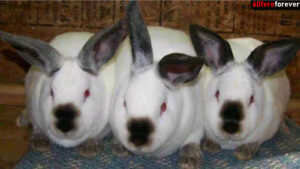
- Origin: The Californian rabbit breed was developed in California, United States, in the early 20th century. It was created by crossing Himalayan, Chinchilla, and New Zealand White rabbits to produce a rabbit with desirable traits for both meat and fur.
- Appearance: Californian rabbits are medium to large-sized rabbits with a commercial body type. They have a sleek, cylindrical body shape with broad shoulders and hindquarters. Their fur is short, dense, and predominantly white with distinctive black markings on the nose, ears, feet, and tail, giving them a striking appearance.
- Temperament: Californian rabbits are known for their calm and friendly temperament, making them suitable as pets and for handling children. They are generally docile and enjoy human companionship, often forming strong bonds with their owners.
- Utility: The Californian rabbit is prized for its dual-purpose capabilities. It is commonly raised for meat production due to its efficient growth rate, meat-to-bone ratio, and tender, flavorful meat. Additionally, Californians are also popular in rabbit shows for their attractive appearance and adherence to breed standards.
- Breeding: Californian rabbits are prolific breeders with large litter, typically ranging from 6 to 10 kits per litter. They have good maternal instincts and are capable of raising their offspring well. Breeding programs focus on maintaining breed standards and improving desirable traits such as fur quality and body conformation.
- Care: Proper care for Californian rabbits involves providing them with a spacious and secure enclosure, a balanced diet rich in hay, fresh vegetables, and pellets, and regular veterinary check-ups to ensure their health and well-being. They also benefit from social interaction and enrichment activities to prevent boredom and promote mental stimulation.
- Show Qualities: Californian rabbits are popular in rabbit shows for their striking appearance and adherence to breed standards. Judges evaluate them based on criteria such as body shape, fur quality, colour distribution, and overall presentation.
3. Champagne d’Argent Rabbit

- Origin: The Champagne d’Argent rabbit breed has a long and storied history, originating in France during the 17th century. It was developed through selective breeding of local wild rabbits and domesticated silver-grey rabbits, resulting in a distinctive champagne-coloured fur.
- Appearance: Champagne d’Argent rabbits are medium to large-sized rabbits with a semi-arch body type. They have a sturdy build with a broad head, strong shoulders, and well-muscled hindquarters. Their fur is dense, soft, and characterized by a unique silver-grey colouration with a champagne-like sheen, particularly on the underside of the body.
- Temperament: Champagne d’Argent rabbits are known for their calm, gentle, and friendly temperament, making them suitable as pets, show animals, and for breeding purposes. They are generally docile and enjoy human companionship, often forming strong bonds with their owners.
- Utility: While Champagne d’Argent rabbits were originally bred for their fur, which was highly prized in the fur trade, they are also valued for their meat production qualities. They have a good meat-to-bone ratio and produce tender, flavorful meat. However, their fur remains an important characteristic, especially in show and exhibition settings.
- Breeding: Champagne d’Argent rabbits are not as prolific breeders as some other rabbit breeds, but they are capable of producing moderate-sized litters. Breeding programs focus on maintaining breed standards and preserving the unique silver-grey fur colouration and champagne-like sheen.
- Care: Proper care for Champagne d’Argent rabbits involves providing them with a spacious and secure enclosure, a balanced diet rich in hay, fresh vegetables, and pellets, and regular grooming to maintain their fur’s lustre and health. They also benefit from social interaction and enrichment activities to prevent boredom and promote mental stimulation.
- Show Qualities: Champagne d’Argent rabbits are prized in rabbit shows for their elegant appearance, unique fur colouration, and overall presentation. Judges evaluate them based on criteria such as body shape, fur quality, colour clarity, and general breed characteristics.
4. Flemish Giant Rabbit
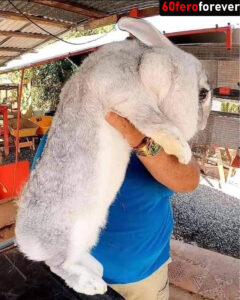
- Origin: The Flemish Giant rabbit originated in Belgium in the 16th century. It was initially bred for meat production, but over time, its gentle temperament and large size also made it popular as a pet and show animal.
- Appearance: Flemish Giant rabbits are among the largest rabbit breeds, with adults typically weighing between 13 to 22 pounds or even more. They have a massive, muscular body with a semi-arched back, broad head, and long, powerful legs. Their fur is dense, and glossy, and comes in various colours, including fawn, black, blue, white, and steel grey.
- Temperament: Despite their imposing size, Flemish Giants are known for their calm, docile, and friendly temperament. They are generally good-natured and enjoy human companionship, often forming strong bonds with their owners. Due to their gentle nature, they are well-suited as pets and are particularly popular among families.
- Utility: While Flemish Giant rabbits were originally bred for meat production, their use has diversified over time. While they still produce flavorful meat, they are also valued as show animals due to their impressive size and elegant appearance. Additionally, their large size makes them suitable for use in therapy programs and as exhibition animals.
- Breeding: Flemish Giant rabbits are not the most prolific breeders, and their large size can present challenges during breeding and birthing. However, they are capable of producing moderate-sized litters, typically ranging from 5 to 12 kits. Breeding programs focus on maintaining breed standards, including size, colour, and overall conformation.
- Care: Proper care for Flemish Giant rabbits involves providing them with a spacious and secure enclosure with plenty of room to move around. They require a balanced diet consisting of hay, fresh vegetables, and high-quality pellets, along with regular grooming to keep their fur healthy and prevent matting. Additionally, they benefit from social interaction and mental stimulation to prevent boredom.
- Show Qualities: Flemish Giant is liked in rabbit shows. People like them because they are very big, look nice, and are friendly.
5. Rex Rabbit

- Origin: The Rex rabbit breed originated in France in the early 20th century. It was developed through the selective breeding of wild rabbits and domesticated breeds to produce a rabbit with a luxurious velvety fur coat.
- Appearance: Rex rabbits have a compact, rounded body with a medium build. They have a distinctive rex fur, which is plush, dense, and velvety to the touch. The fur lacks the typical guard hairs found in other rabbit breeds, giving it a unique texture. Rex rabbits come in a variety of colours and patterns, including castor, chinchilla, opal, and blue.
- Temperament: Rex rabbits are known for their calm, docile, and friendly temperament. They are typically gentle and enjoy human companionship, making them well-suited as pets. They often form strong bonds with their owners and can be affectionate companions.
- Utility: While originally bred for their fur, which is highly prized in the fur industry, Rex rabbits are also raised for meat production and as show animals. They have a good meat-to-bone ratio and produce tender, flavorful meat. Additionally, their unique fur makes them popular in rabbit shows for their distinctive appearance.
- Breeding: Rex rabbits are known for their reproductive efficiency and can produce large litters of kits. Breeding programs focus on maintaining the desired fur texture and colouration, as well as overall body conformation. Careful breeding is necessary to preserve the unique qualities of the Rex breed.
- Care: Proper care for Rex rabbits involves providing them with a spacious and secure enclosure, a balanced diet rich in hay, fresh vegetables, and pellets, and regular grooming to maintain their fur’s plush texture and prevent matting. They also benefit from social interaction and enrichment activities to keep them mentally stimulated.
- Show Qualities: Rex rabbits are popular in rabbit shows for their unique fur texture and variety of colours and patterns. We classify them based on criteria such as fur quality, colour clarity, body shape, and overall presentation.
6. American Chinchilla Rabbit
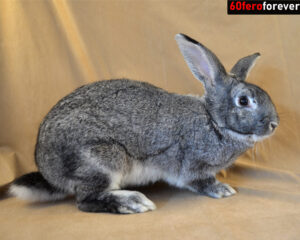
Origin: The American Chinchilla rabbit breed was developed in the United States in the early 20th century. It was created through selective breeding of Chinchilla-type rabbits imported from Europe, to produce a rabbit with superior fur qualities and meat production capabilities.
Appearance: American Chinchilla rabbits are not too big or too small. They have strong bodies. Their fur is soft and fluffy, with a grey-blue colour underneath and black tips on top. They look like chinchillas, that’s why they are called chinchillas.
Temperament: American Chinchilla rabbits are calm and friendly. They like being around people, even children. They can become good friends with their owners.
Utility: People used to breed American Chinchilla rabbits for their fur, which was valuable. Now, they also raise them for meat because they have a good amount of meat on their bones. People like showing them off in rabbit shows too.
Breeding: These rabbits can have many babies at once and take care of them well. Breeding programs focus on keeping the breed’s special qualities, like fur colour and body shape.
Care: Taking care of American Chinchilla rabbits means giving them enough space, and good food, and keeping their fur clean. They also need attention and things to do for fun.
Show Qualities: American Chinchilla rabbits are famous in rabbit shows because of their beautiful fur and how well they match the breed standards. Judges look at their fur, colour, body shape, and how look overall.
7. Satin Rabbits
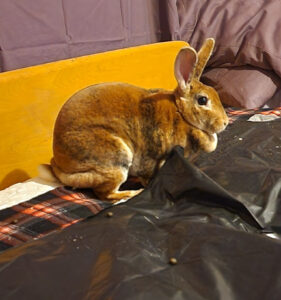
- Origin: Satin rabbits originated in the United States in the 1930s through selective breeding programs aimed at creating a rabbit with glossy, satin-like fur.
- Appearance: Satin rabbits have medium-sized bodies with a sleek and glossy fur coat that reflects light, giving them a satin-like sheen. Their fur is characterized by a translucent outer layer, which contributes to its unique shine. Satin rabbits come in various colours and patterns, including solid, broken, and shaded varieties.
- Temperament: Satin rabbits are known for their calm, friendly, and sociable temperament. They are generally docile and enjoy human interaction, making them well-suited as pets and for handling by children. They often form strong bonds with their owners and can be affectionate companions.
- Utility: While Satin rabbits are primarily bred for their unique fur qualities, they are also raised for meat production and as show animals. They have a good meat-to-bone ratio and produce tender, flavorful meat. Additionally, their glossy fur makes them popular in rabbit exhibitions and shows.
- Breeding: Satin rabbits are capable of producing large litters of kits and have good maternal instincts. Breeding programs focus on maintaining and improving the unique fur characteristics of the breed, as well as overall body conformation. Careful selection of breeding stock is essential to preserve the desired traits.
- Care: Proper care for Satin rabbits involves providing them with a spacious and secure enclosure, a balanced diet rich in hay, fresh vegetables, and pellets, and regular grooming to maintain their fur’s lustre and health. They also benefit from social interaction and enrichment activities to keep them mentally stimulated.
- Show Qualities: Satin rabbits are prized in rabbit shows for their glossy fur, unique sheen, and adherence to breed standards. They are judged based on criteria such as fur quality, colour clarity, body shape, and overall presentation.
8. Silver Fox Rabbit
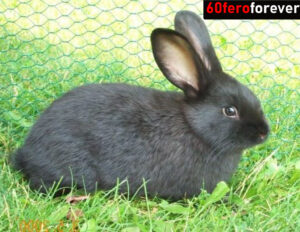
- Origin: The Silver Fox rabbit breed was developed in the United States in the early 20th century, with the first specimens appearing in 1925. It was created through selective breeding of black and wild-coloured rabbits to produce a rabbit with a silver-tipped fur coat.
- Appearance: Silver Fox rabbits are medium to large-sized rabbits with a semi-arched body type. They have a sturdy build with broad shoulders, deep chests, and strong hindquarters. Their fur is dense, plush, and characterized by a striking silver-tipped colouration, giving them a distinctive appearance. The fur is longer and softer than that of many other rabbit breeds.
- Temperament: Silver Fox rabbits are known for their calm, friendly, and docile temperament. They are generally gentle and enjoy human interaction, making them suitable as pets and for handling by children. They often form strong bonds with their owners and can be affectionate companions.
- Utility: While originally bred for their fur, which was highly prized in the fur industry, Silver Fox rabbits are also raised for meat production. They have a good meat-to-bone ratio and produce tender, flavorful meat. Additionally, their attractive appearance makes them popular as show animals in rabbit exhibitions.
- Breeding: Silver Fox rabbits are capable of producing large litters of kits and have good maternal instincts. Breeding programs focus on maintaining breed standards, including fur colouration, body conformation, and overall health. Careful selection of breeding stock is essential to preserve the desired traits.
- Care: Proper care for Silver Fox rabbits involves providing them with a spacious and secure enclosure, a balanced diet rich in hay, fresh vegetables, and pellets, and regular grooming to maintain their fur’s lustre and prevent matting. They also benefit from social interaction and enrichment activities to keep them mentally stimulated.
- Show Qualities: Silver Fox rabbits are prized in rabbit shows for their distinctive fur colouration, plush fur, and adherence to breed standards. Judges evaluate them based on criteria such as fur quality, colour clarity, body shape, and overall presentation.
9. Creme d’Argent
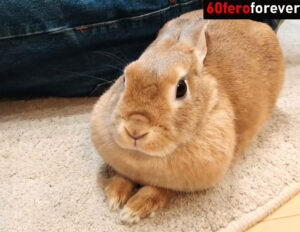
- Origin: The Creme d’Argent rabbit breed originated in France in the late 19th century. It was developed through selective breeding of Champagne d’Argent and Havanna rabbits to produce a rabbit with a distinctive creamy fur colouration.
- Appearance: Creme d’Argent rabbits have a medium-sized body with a compact and muscular build. They have a lush fur coat that is soft, dense, and characterized by creamy or champagne-coloured fur with subtle shading. Their fur has a luxurious texture and appearance, making them stand out among other rabbit breeds.
- Temperament: Creme d’Argent rabbits are known for their calm, docile, and friendly temperament. They are generally gentle and enjoy human interaction, making them well-suited as pets and for handling by children. They often form strong bonds with their owners and can be affectionate companions.
- Utility: While Creme d’Argent rabbits were originally bred for their fur, which was highly prized in the fur industry, they are also raised for meat production. They have a good meat-to-bone ratio and produce tender, flavorful meat. Additionally, their attractive appearance makes them popular as show animals in rabbit exhibitions.
- Breeding: Creme d’Argent rabbits are capable of producing large litters of kits and have good maternal instincts. Breeding programs focus on maintaining breed standards, including fur colouration, body conformation, and overall health. Careful selection of breeding stock is essential to preserve the desired traits.
- Care: Proper care for Creme d’Argent rabbits involves providing them with a spacious and secure enclosure, a balanced diet rich in hay, fresh vegetables, and pellets, and regular grooming to maintain their fur’s lustre and prevent matting. They also benefit from social interaction and enrichment activities to keep them mentally stimulated.
- Show Qualities: Creme d’Argent rabbits are prized in rabbit shows for their distinctive fur colouration, lush fur, and adherence to breed standards. Judges evaluate them based on criteria such as fur quality, colour clarity, body shape, and overall presentation.
Final Thoughts
Raising rabbits for meat production can be a rewarding experience. When choosing a breed, consider factors such as size, meat yield, temperament, and adaptability to your climate.
The breeds discussed in this article are some of the best rabbits for meat production, but there are many other breeds to choose from as well. With proper care and management, you can raise healthy and delicious meat rabbits on your farm or homestead.
Feel free to link to the website if this article is helpful.